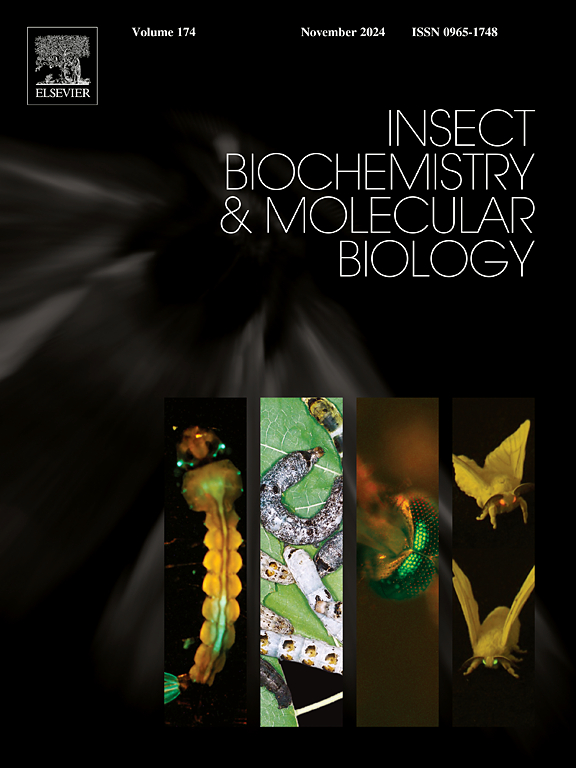HiHR4 regulates chitin metabolism during molting of Hermetia illucens
IF 3.7
2区 农林科学
Q2 BIOCHEMISTRY & MOLECULAR BIOLOGY
引用次数: 0
Abstract
The black soldier fly (Hermetia illucens) as a model bio-converter insect, is increasingly used in feed formulation and as a fertilizer source. Its growth rate and biomass yield are influenced by molting, a process involving the remodeling of chitinous structures. In this study, we identified a HiHR4 gene in Hermetia illucens and report its function in larval growth and molting. RT-qPCR results show that HiHR4 expression is stable during the third instar larval stage but peaks sharply prior to molting. Knockdown of HiHR4 by RNA interference (RNAi) in larvae results in molting delay. The dsHiHR4-injected larvae display slow growth. Consistently, integument sectioning and chitin staining showed that HiHR4 knockdown inhibits both the degradation of the old cuticle and the formation of new cuticle. In addition, HiHR4 and chitin metabolism-related genes are induced by the steroid hormone 20-hydroxyecdysone (20E), indicating their responsiveness to 20E signaling. Moreover, HiHR4 knockdown significantly suppresses the expression of chitin synthesis genes (HiHex, HiG6PI, HiCHS1) and chitin degradation genes (HiCht10). RNAi against HiCHS1 or HiCht10 disrupts larval molting and attenuates growth. Taken together, these findings suggest that HiHR4 is a key regulator of chitin metabolism, ensuring proper molting and promoting biomass production in H. illucens.

HiHR4调控黄颡鱼蜕皮过程中几丁质代谢
黑兵蝇(Hermetia illucens)作为一种典型的生物转化昆虫,越来越多地用于饲料配方和肥料来源。它的生长速度和生物量产量受蜕皮的影响,这是一个涉及几丁质结构重塑的过程。在这项研究中,我们鉴定了一种HiHR4基因,并报道了其在黑蝇幼虫生长和蜕皮中的功能。RT-qPCR结果显示,HiHR4的表达在3龄幼虫期较为稳定,在蜕皮前达到峰值。通过RNA干扰(RNA interference, RNAi)敲低HiHR4可导致幼虫蜕皮延迟。注射dshihr4的幼虫生长缓慢。被皮切片和几丁质染色一致显示,HiHR4敲低抑制旧角质层的降解和新角质层的形成。此外,HiHR4和几丁质代谢相关基因受到类固醇激素20-羟基蜕皮激素(20E)的诱导,表明它们对20E信号的响应性。HiHR4敲低显著抑制几丁质合成基因(HiHex、HiG6PI、HiCHS1)和几丁质降解基因(HiCht10)的表达。针对HiCHS1或HiCht10的RNAi破坏了幼虫的蜕皮并减弱了生长。综上所述,这些研究结果表明,HiHR4是几丁质代谢的关键调节因子,确保了H. illucens的适当蜕皮并促进了生物量的产生。
本文章由计算机程序翻译,如有差异,请以英文原文为准。
求助全文
约1分钟内获得全文
求助全文
来源期刊
CiteScore
7.40
自引率
5.30%
发文量
105
审稿时长
40 days
期刊介绍:
This international journal publishes original contributions and mini-reviews in the fields of insect biochemistry and insect molecular biology. Main areas of interest are neurochemistry, hormone and pheromone biochemistry, enzymes and metabolism, hormone action and gene regulation, gene characterization and structure, pharmacology, immunology and cell and tissue culture. Papers on the biochemistry and molecular biology of other groups of arthropods are published if of general interest to the readership. Technique papers will be considered for publication if they significantly advance the field of insect biochemistry and molecular biology in the opinion of the Editors and Editorial Board.

 求助内容:
求助内容: 应助结果提醒方式:
应助结果提醒方式:


